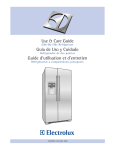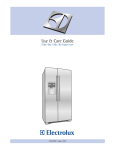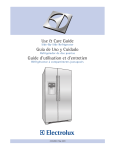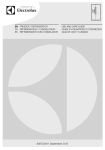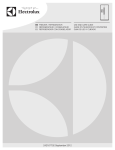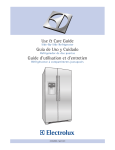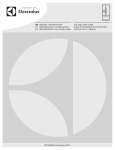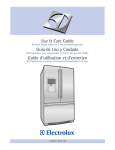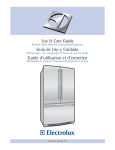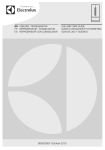Download AEG Automatic Refrigerator Use & care guide
Transcript
Use & Care Guide Side-By-Side Refrigerator 241988200 January 2009 Downloaded from Fridge-Manual.com Manuals customer information Safety Customer Information? For online support and product information visit http://www.electroluxfilters.com • It is dangerous to alter the specifications or modify this product in any way. Any damage to the cord may cause a short-circuit and/or electric shock. • This appliance is heavy. Care should be taken when moving it. • Do not move or touch items from the freezer compartment if your hands are damp/wet, as this could cause skin abrasions or frost/ freezer burns. • Avoid prolonged exposure of the appliance to direct sunlight. Table of contents Customer information .........................................................2 Important safety instructions................................................ 2 Installation...................................................................... 3 Removing The Doors.......................................................... 4 Installing Door Handles....................................................... 4 Connecting The Water Supply............................................... 5 Controls......................................................................... 6 Storage Features............................................................... 7 Automatic Ice & Water Maker/Dispenser.................................. 8 Locating and Replacing The Filter.......................................... 9 Care & Cleaning.............................................................. 10 Solutions To Common Problems........................................... 11 For the safety of life and property keep the precautions of these user’s instructions as the manufacturer is not responsible for damages caused by omission. Children and vulnerable people safety DANGER - indicates an imminently hazardous situation which, if not avoided, will result in death or serious injury. • This appliance is not intended for use by persons (including children) with reduced physical, sensory or mental capabilities, or lack of experience and knowledge, unless they have been given supervision or instruction concerning use of the appliance by a person responsible for their safety. Children should be supervised to ensure that they do not play with the appliance. • Keep all packaging well away from children. There is risk of suffocation. • If you are discarding the appliance pull the plug out of the socket, cut the connection cable (as close to the appliance as you can) and remove the door to prevent playing children to suffer electric shock or to close themselves into it. • If this appliance featuring magnetic door seals is to replace an older appliance having a spring lock (latch) on the door or lid, be sure to make that spring lock unusable before you discard the old appliance. This will prevent it from becoming a death trap for a child. WARNING - indicates a potentially hazardous situation which, if not avoided, could result in death or serious injury. CAUTION - indicates a potentially hazardous situation which, if not avoided, may result in minor or moderate injury. Important - Indicates installation, operation or maintenance information which is important but not hazard-related. General Safety • Do not store or use gasoline, or other flammable liquids, near this or any other appliance. Read product labels for warnings regarding flammability and other hazards. • Do not operate the refrigerator in the presence of explosive fumes. • Avoid contact with any moving parts of the automatic ice maker. • Remove all staples from the carton to avoid cut injuries. Staples can also damage finishes if they come in contact with other appliances or furniture. • The appliance is intended for keeping foodstuff and/or beverages in a normal household as explained in this instruction booklet. Install this appliance at a location where the ambient temperature corresponds to the climate class indicated on the rating plate of the appliance: Climate Class • Do not use mechanical devices or other means to accelerate the defrosting process, other than those recommended by the manufacturer. • Do not use other electrical appliances (such as ice cream makers) inside of refrigerating appliances, unless they are approved for this purpose by the manufacturer. • The refrigerant isobutane (R600a) is contained within the refrigerant circuit of the appliance, a natural gas with a high level of environmental compatibilty, which is nevertheless flammable. During transportation and installation of the appliance, be certain that none of the components of the refrigerant cycle become damanged. If the refrigerant circuit should become damaged: - avoid open flames and sources of ignition. Downloaded from Fridge-Manual.com Manuals In the interest of your safety and to ensure the correct use, before installing and first using the appliance, read the user manual carefully, including its hints and warnings. To avoid unnecessary mistakes and accidents, it is important to ensure that all people using the appliance are thoroughly familiar with its operation and safety features. Save these instructions and make sure that they remain with the appliance if it is moved or sold, so that everyone using it through its life will be properly informed on appliance use and safety. Important safety instructions - thoroughly ventilate the room in which the appliance is situated Ambient Temperature SN +10°C to + 32°C N +16°C to + 32°C ST +18°C to + 36°C T +18°C to + 43°C Environment Protection This appliance does not contain gasses which could damage the ozone layer, in either its refrigerant circuit or insulation materials. The appliance shall not be discarded together with the urban refuse and rubbish. The insulation foam contains flammable gases: the appliance shall be disposed according to the applicable regulations to obtain from your local authorities. Avoid damaging the cooling unit, especially at the rear near the heat exchanger. The materials used on this appliance marked by the symbo are recyclable. 2 Installation / REMOVING THE DOORS Door opening Electrical information NOTE - The refrigerator doors are designed to shut by themselves within a 20 degree opening. WARNING - You must follow these guidelines to ensure that your refrigerator’s safety mechanisms are operating correctly. Your refrigerator should be positioned to allow easy access to a counter when removing food. For best use of drawers and freezer baskets, the refrigerator should be in a position where both the refrigerator and freezer doors can be fully opened. • The refrigerator must be plugged into its own dedicated 220-240 Volt, 50/60 Hz., AC-only electric outlet. The receptacle must be installed in accordance with local codes and ordinances. Consult a qualified electrician. Do not use an extension cord or adapter plug. • If the power cord is damaged, it should be replaced by the manufacturer, service technician or a qualified person to prevent any risk. • Never unplug the refrigerator by pulling on the power cord. Always grip the plug firmly, and pull straight out from the receptacle to prevent damaging the power cord. • Unplug the refrigerator before cleaning and before replacing a light bulb to avoid electrical shock. • Performance may be affected if the voltage varies by 10% or more. Operating the refrigerator with insufficient power can damage the compressor. Such damage is not covered under your warranty. • Do not plug the unit into an outlet controlled by a wall switch or pull cord to prevent the refrigerator from being turned off accidentally. • Avoid connecting refrigerator to a Ground Fault Interrupter (GFI) circuit. • Electric shock and fire hazard can cause serious injury or death. Service must be performed by qualified personnel only. Dimension of the recess Height 1788 mm Width 905 mm Depth 716 mm Rising Time 20 h Guidelines for final positioning of your refrigerator: • All four corners of the cabinet must rest firmly on the floor. • The cabinet should be level at the front and rear. • The cabinet should tilt 6.4 mm from front to back (to ensure that doors close and seal properly). • Doors should align with each other and be level. All of these conditions can be met by raising or lowering the adjustable front rollers. To level the cabinet using the front rollers: 1 Open both doors and remove the toe grille by gently pulling forward (see illustration). 2 Close the doors and use a flat-blade screwdriver or 9.5 mm (3/8 inch) socket wrench to raise or lower the front rollers. 3 Ensure both doors are bind-free with their seals touching the cabinet on all four sides. Important - To turn off power to your refrigerator, unplug the power cord from the wall outlet. This Use & Care Guide provides general operating instructions for your model. Use the refrigerator only as instructed in this Use & Care Guide. Before starting the refrigerator, follow these important first steps. Location • Choose a place that is near a grounded electrical outlet. Do Not use an extension cord or an adapter plug. • If possible, place the refrigerator out of direct sunlight and away from the range, dishwasher or other heat sources. • The refrigerator must be installed on a floor that is level and strong enough to support a fully loaded refrigerator. • Consider water supply availability for models equipped with an automatic ice maker. To level the doors using the adjustable lower hinge (some models): 1 If the refrigerator door is lower than the freezer door, raise the refrigerator door by turning the adjustment screw clockwise using a 11 mm socket wrench. (See illustration.) 2 If the freezer door is lower than the refrigerator door, raise the freezer door by turning the adjustment screw clockwise using a 11 mm socket wrench. (See illustration.) 3 After leveling, verify door stop contacts lower hinge and top of door does not contact upper hinge through full movement of door (from fully closed to fully open). 4 Replace the toe grille by fitting it into place. CAUTION - DO NOT install the refrigerator where the temperature will drop below 13°C or rise above 43°C. The compressor will not be able to maintain proper temperatures inside the refrigerator. DO NOT block the toe grille on the lower front of your refrigerator. Sufficient air circulation is essential for the proper operation of your refrigerator. Installation Open Door Installation clearances Door Stop Flange • Allow the following clearances for ease of installation, proper air circulation, and plumbing and electrical connections: Sides & Top Back Hinge 9.5 mm 25.4 mm Downloaded from Fridge-Manual.com Manuals Hinge Flange 3 11.1 mm (7/16 inch) Socket or Wrench OR REMOVING THE DOORS / INSTALLING DOOR HANDLES Getting through narrow spaces 2 Trace lightly around the hinge with a pencil. This makes reinstallation easier. If your refrigerator will not fit through an entrance area, you can reduce its size by removing the doors. Check first by measuring the entrance. 3 Detach the water tube from the connector located below the freezer door. The connector releases when you press its outer sleeve inward. To prepare for removing the doors: 1 Make sure the electrical power cord is unplugged from the wall outlet. 2 Open both doors and remove the toe grille (as explained in the Installation Instructions that came with your appliance). 3 Remove any food from the door shelves. 4 Close the doors. To remove the refrigerator top hinge cover: 1 Remove the three screws from each cover over the top door hinges. 2 Lift hinge cover straight up and off. Non-Adjusting Hinge (some models) 4 Remove the screws from the top hinge and pull the multi-wire cable through it. Lift the door off of the bottom hinge. Adjustable Hinge (some models) To remove the refrigerator door: 1 Trace lightly around the door’s top hinge with a pencil. This makes reinstallation easier. 5 Remove the two bottom hinge screws and hinge if necessary. 6 Lay the door on its side to avoid damage to the water tube extending from the bottom hinge. To reinstall the freezer door, reverse the above steps. Once both doors are in place, ensure they are aligned with each other and level (Please see “To level the doors using the lower hinge” for models with adjustable lower hinges or “To level the cabinet using the front rollers” for models with the non-adjustable lower hinges in the “Installation” section.), then replace the top hinge cover. 2 Remove the two screws from the top hinge. Lift the door off of the bottom hinge and set it aside. Door Handle Mounting Instructions 1 Remove handles from carton and any other protective packaging. 2 Position freezer handle end caps over upper and lower preinstalled shoulder bolts (A) that are fastened into door, ensuring the holes for the set screws are facing towards the refrigerator door. 3 While holding handle firmly against door, fasten upper and lower Allen set screws (B) with supplied Allen wrench. Adjustable Hinge (some models) Non-Adjusting Hinge (some models) 3 Remove the two bottom hinge screws and hinge if necessary. 4 Repeat steps 2 and 3 to install refrigerator handle. Ensure the holes for the set screws are facing towards the freezer door. To reinstall the refrigerator door, reverse the above steps. CAUTION - Be sure doors are set aside in a secure position where they cannot fall and cause personal injury. To remove the freezer top hinge cover: 1 Remove the two screws from each cover over the top door hinges. 2 Lift hinge cover straight up and off. To remove the freezer door: 1 Detach the multi-wire cable connector located above the top hinge. Grasp both sides of the connector firmly and pull apart. Downloaded from Fridge-Manual.com Manuals NOTE - All set screws should be tightened and sub-flush (Allen set screw should be seated just below the surface of the end cap) of handle end cap. The end caps should be drawn tight to freezer and refrigerator doors with no gaps. 4 connecting the water supply / controls B Upper End Cap clamp and screw (see illustration). A A 8 Coil the excess water tubing (about 2½ turns) behind your refrigerator as shown. Arrange coiled tubing to avoid vibration or wear against other surfaces. 9 Open water supply shut-off valve and tighten any connections that leak. B NOTE - After connecting the water supply, refer to “How to Prime the Water Supply System” for important information about priming an empty water supply system. Lower End Cap About your refrigerator’s water supply The automatic ice & water dispenser on your refrigerator requires a permanent water supply to function correctly. During installation, you (or a service professional) establish this water supply by connecting a water tube from your household water system to a valve at the rear of the refrigerator. Your refrigerator’s water supply system includes several tubing lines, a water filter, a water valve and a water tank. To ensure that your water dispenser works properly, this system must be completely filled with water when your refrigerator is first connected to the household water supply line. You may have already followed the directions in the Installation Instructions to connect the water supply. This information is repeated here for future reference if you need to relocate your refrigerator. CAUTION - To avoid property damage: • Use water tubing for the water supply line (plastic tubing is more likely to leak). Manufacturer is not responsible for any damage if plastic tubing is used for supply line. • Ensure water supply and installation comply with state and local laws and regulations. Wave-TouchTM (some ConTROLS models) Your refrigerator is equipped with a Wave-TouchTM Panel user interface display. It is only necessary to touch the glass. There is no need to press with force. There are three levels of display. • For proper dispenser operation, recommended water supply pressure should fall between 210 kPa (2.1 bar) and 690 kPa 1st Level: Sleep Mode (6.9 bar). Excessive pressure may cause water filter to malfunction. What you will need: • Access to a cold water line with pressure of 210 kPa (2.1 bar) to 690 kPa (6.9 bar). (System supplied with cold water only.) • Water tubing with 6.4 mm Outside Diameter (OD). Length for this tubing is the distance from the rear of the refrigerator to your household water supply line plus 2.1 meters. • A shut-off valve for the connection between your household water line and the refrigerator supply line. Sleep mode displays only the water, cubes and crushed options. Touch an icon to activate the desired dispenser mode. The active dispenser mode is more brightly illuminated. Do not use a self-piercing shut-off valve. • A compression nut and ferrule (sleeve) for the water supply connection at the rear of your refrigerator. To connect the water supply to the rear of your refrigerator: 1 Ensure that the refrigerator is not plugged in. 2 Flush the supply line until water is clear by placing the end of the water tube in a sink or bucket and opening the shut-off valve. 2nd Level: Awakened Display Mode 3 Remove the plastic cap from the water valve inlet at the rear of your refrigerator. Discard the cap. The display is awakened by touching anywhere on the glass where there is an indicator. Black space will not awaken the display. After 10 seconds of inactivity, the display will return to the Sleep mode. 4 Slide the brass compression nut, then the ferrule (sleeve) onto water tube. The following dispenser options are illuminated: 5 Push the water tube into water valve inlet as far as it will go (6.4 mm). fast freeze - Activates a faster rate for freezing food fast ice- Increases the production of ice dispenser light - On / Off 6 Slide the ferrule (sleeve) into valve and finger-tighten the compression nut onto valve. Tighten another half turn with a wrench. Do not over-tighten. control lock - Press and hold for three seconds to activate and deactivate. This restricts undesired changes to the refrigerators settings and prevents use of the ice and water dispenser. 7 Secure the water tube to your refrigerator’s rear panel with a steel Downloaded from Fridge-Manual.com Manuals 5 CONTROLS Alarms 3rd Level: User Variable Options Door Ajar - If the door has been left open for an extended period of time, an alarm will sound and the door ajar indicator will display in the middle. The alarm is turned off by closing the door. The alarm off key will illuminate to prompt the reset of any pending alarms. Press this key to reset any system Alarms. High Temp - In the event of a high temperature condition, the temperature display will display “HI”. After 20 minutes, the high temp alert will be displayed and the alarm off icon will illuminate until pressed, acknowledging the alarm, at which time the highest temperature reached will be displayed and the refrigerator will resume normal operation. All other modes are turned off until the alarm is acknowledged. Power Fail - In the event of a power failure, the power fail alert will be displayed and the alarm off key will be illuminated and you will hear an audible alarm until the alarm off icon is pressed, acknowledging the alarm. Other modes may be turned off until the alarm is acknowledged. When the power fail alert is turned off, the refrigerator will resume normal operation. The high temp alarm may also be illuminated until a safe operating range temperature has been reached. Touching the options icon displays the following options: vacation mode - Conserves energy by increasing the time between automatic defrost. This feature is automatically activated during long periods between door openings. Vacation mode is manually activated when the red indicator is lit. Wave-TouchTM/IQ-TouchTM “Sabbath Mode” (some models) water filter - Touch to display filter condition status. Press and hold for three seconds to reset. The Sabbath Mode is a feature that disables portions of the refrigerator and its controls for both Wave-TouchTM and IQ-TouchTM, in accordance with observance of the weekly Sabbath and religious holidays within the Orthodox Jewish community. air filter - Touch to display filter status. Press and hold for three seconds to reset. temp display - When active, it allows the display of the freezer and fridge temps during “Sleep Mode”. The temperature is displayed when the red indicator is lit. temp mode - Touch to toggle display from Fahrenheit to Celsius. Sabbath Mode is turned ON and OFF by pressing and holding both the outermost “-” and “+” indicators for five seconds for both the WaveTouchTM and IQ-TouchTM modes. The display shows “Sb” while in Sabbath mode. mute sounds - Tones emitted by each keypress can be turned off based on user preference. The sounds are muted when the red indicator is lit. Warning signals will stay active. factory default - Resets all refrigerator settings such as temp, temp display, and alarm tones to their factory default settings. In the Sabbath Mode, the High Temp alarm is active for health reasons. If a high temperature alarm is activated during this time, for example due to a door left ajar, the alarm will sound intermittently for about 10 minutes. The alarm will then silence on its own and a red high temperature icon will display. The high temp icon will continue to display, even if the door is closed, until the Sabbath mode is exited and the icon reset. The refrigerator will function normally once the door is closed, without any violation of the Sabbath/Holidays. on off - Press and hold for three seconds to turn off the cooling system to clean the refrigerator. It also turns off all dispenser functions. The temperature display will read OFF. IMPORTANT - Pressing the system off icon does not turn off power to your refrigerator. You must unplug the power cord from the wall outlet. Setting cooling temperatures 1 Touch the glass panel to illuminate the 2nd level of display. 2 Select the options icon. Plus (+) and minus (-) indicators will appear on either side of the displayed temperatures. 3 Press the + or – indicator to adjust the temperature to the desired setting. The temperature display will begin to blink with the first touch. After five seconds of inactivity, the display will beep to accept the new temperature. After 10 seconds, the display times out and returns to the basic display. IQ-TouchTM (some models) Downloaded from Fridge-Manual.com Manuals 6 Controls / storage features Door Ajar - If the door has been left open for an extended period of time, an alarm will sound and the door ajar indicator will display on the right side of the display. The alarm is turned off by closing the door. The mute sounds key will illuminate to prompt the reset of any pending alarms. Press this key to reset any system alarms. Your refrigerator is equipped with a Glass Touch Panel user interface display. It is only necessary to touch the glass. There is no need to press with force. There are three dispenser modes: 1 Water High Temp - In the event of a high temperature condition, the temperature display will display “HI”. After 20 minutes, the high temp alert will be displayed and the mute sounds icon will illuminate until pressed, acknowledging the alarm, at which time the highest temperature reached will be displayed and the refrigerator will resume normal operation. All other modes are turned off until the alarm is acknowledged. 2 Ice Cubes 3 Crushed Ice A red indicator light will be illuminated above the active mode. Touch the icon to activate the options below. Any of the following options that are activated have a red indicator light above the icon. fast ice - Increases the production of ice Power Fail - In the event of a power failure, the power fail alert will be displayed and the mute sounds icon will be illuminated and you will hear an audible alarm until the mute sounds icon is pressed, acknowledging the alarm. Other modes may be turned off until the alarm is acknowledged. When the power fail alert is turned off the refrigerator will resume normal operation. The high temp alarm may also be illuminated until a safe operating range temperature has been reached. fast freeze - Activates a faster rate for freezing food dispenser light - On / Off control lock - Press and hold for three seconds to activate and deactivate. This restricts undesired changes to the refrigerators settings and prevents use of the ice and water dispenser. Storage Features vacation mode - Conserves energy by increasing the time between automatic defrost. This feature is automatically activated during long periods between door openings. Vacation mode is manually activated when the red indicator is lit. CAUTION - To avoid injury from breakage, handle tempered glass shelves carefully. water filter - Touch to display filter condition status. Press and hold for three seconds to reset. air filter - Touch to display filter status. Press and hold for three seconds to reset. temp display - Touch to toggle the freezer and fridge temps display on and off. Touch and hold temp display to toggle display from Fahrenheit to Celsius. NOTE - Features may vary according to model. You can easily adjust shelf positions in the freezer and fresh food compartments to suit your needs. The shelves have mounting brackets which attach to slotted supports at the rear of each compartment. mute sounds - Tones emitted by each keypress can be turned off based on user preference. The sounds are muted when the red indicator is lit. Warning signals will stay active. factory default - Resets all refrigerator settings such as temp, temp display and ring tones to their factory default settings. Crisper humidity control Crisper drawers include a sliding control for adjusting the humidity inside the crisper. This feature can extend the life of certain fresh vegetables that keep longer in high humidity. on off - Press and hold for three seconds to turn off the cooling system to clean the refrigerator. It also turns off all dispenser functions. The temperature display will read OFF. IMPORTANT - Pressing the system off icon does not turn off power to your refrigerator. You must unplug the power cord from the wall outlet. Setting cooling temperatures 1 Touch the glass panel to illuminate the display to the Plus (+) and minus (-) indicators which appear on either side of the displayed temperatures. Meat keeper/Cold Zone 2 Press the + or – indicator to adjust the temperature to the desired setting. Some models are equipped with a meat keeper drawer for short-term storage of bulk meat items. This drawer includes a sliding control for adjusting the temperature inside. The temperature display will begin to blink with the first touch. The display times out after 5 seconds and returns to the basic display. Alarms Any meat to be kept longer than two days should be frozen. If you store fruits or vegetables in this drawer, set it to a warmer temperature to prevent freezing. Downloaded from Fridge-Manual.com Manuals 7 STORAGE FEATURES / Automatic Ice & Water Maker/Dispenser Dairy compartment IMPORTANT - Your ice maker is turned on at the factory so it can work as soon as you install your refrigerator. If you cannot connect a water supply, turn the ice maker’s On/Off switch to Off. Otherwise, the ice maker’s fill valve may make a loud chattering noise when it attempts to operate without water. Use the dairy compartment, at the top of the fresh food compartment door, for short term storage of cheese, spreads, or butter. The dairy compartment, which includes a lift-up cover that may be locked and a dairy divider (some models), is designed to be warmer than the open storage area to accommodate these types of food. Using the ice maker after installation Before making ice for the first time, be sure to prime the water supply system. Air in new plumbing lines can result in two or three empty ice maker cycles. Furthermore, if the system is not flushed, the first ice cubes may be discolored or have an odd flavor. Priming the water supply system ON Wire Signal Arm Turning the ice maker on and off Your refrigerator’s water supply system includes several tubing lines, an advanced water filter, a distribution valve bank, and a reserve tank to ensure ample supply to the ice and water dispenser at all times. This system needs to be completely filled with water when first connected to an external supply line. Ice production is controlled by the ice maker’s On/Off power switch. To gain access to the ice maker, pull the extra shelf out (some models). Press the switch to the “O” position to turn it Off and press to the “I” position to turn it On. NOTE - The ice maker also has a built-in wire signal arm, which automatically stops ice production when the ice bin is full. This signal arm should not be used to manually stop the ice maker. WARNING - Connect to potable water only. Minimum supply water pressure = 210 kPa (2.1 bar). Maximum supply water pressure = 690 kPa (6.9 bar). IMPORTANT - Small ice cubes or ice chips jamming in the ice maker may be a sign that your water filter needs changing. If you have a side mounted ice maker you may also experience hollow cubes -- partially frozen cubes with water inside. When these cubes are harvested they break open and spill water over the other ice cubes in the ice container, forming a solid mass of ice. As the water filter nears the end of its useful life and becomes clogged with particles, less water is delivered to the ice maker during each cycle. The ice maker can’t fill every cube in the ice maker mold, leading to small cubes or chips that can get caught between the ice ejector blades and the stripper. Remember, if your ice maker is jamming with small ice cubes or it’s been six months or longer since you last changed your water filter, replace the water filter with a new one. Poor quality household water may require the filter to be changed more frequently. CAUTION - For proper dispenser operation, recommended water supply pressure should fall between 210 kPa (2.1 bar) and 690 kPa (6.9 bar). Excessive pressure may cause water filter to malfunction. To prime the water supply system: 1 Begin filling the tank by pressing and holding a drinking glass against the water dispenser paddle. 2 Keep the glass in this position until water comes out of the dispenser. It may take about 1½ minutes. 3 Continue dispensing water for about three minutes to flush the system and plumbing connections of any impurities (stopping to empty the glass as necessary). Ice maker/dispenser tips NOTE - The water dispenser has a built-in device that shuts off the water flow after three minutes of continuous use. To reset this shutoff device, simply release the dispenser paddle. WARNING - Incorporated ice makers are to be installed only by the manufacturer or its service agent. Ice maker operation & care The ice maker, ice bin, and dispenser feeding mechanism are located in the top of the freezer compartment. After the refrigerator is installed properly and has cooled for several hours, the ice maker can produce ice within 24 hours. It can completely fill an ice bin in about two days. • Ice cubes stored too long may develop an odd flavor. Empty the ice container as explained below. • Occasionally shake the ice container to keep ice separated. • If your refrigerator is not connected to a water supply or the water supply is turned off, turn off the ice maker by pressing the On/Off switch. • If you need a large quantity of ice at one time, it is best to get cubes directly from the ice container. • The following sounds are normal when the ice maker is operating: - Motor running - Ice dropping into ice container - Water valve opening or closing - Ice loosening from tray The ice maker produces 1.8 to 2.7 kg of ice every 24 hours depending on usage conditions. Ice is produced at a rate of eight cubes every 75 to 90 minutes. Downloaded from Fridge-Manual.com Manuals OFF 8 - Running water • When dispensing ice, you will hear a snapping or clicking sound when the ice chute opens and closes. • Turn off the ice maker when cleaning the freezer and during vacations. Automatic Ice & Water Maker/Dispenser Air filter - If you turn off the ice maker for a long period of time, you should also turn off the water supply valve. The air filter is located at the top of the fresh food compartment next to the water filter. Cleaning the ice maker Replacing the air filter Clean the ice maker and ice bin at regular intervals, particularly before you take a vacation or move. In general, you should change the air filter every six months (the filter status light on the Touch Panel prompts you to replace the filter after six months) to ensure optimal filtering of refrigerator odors. You may want to adjust this time period depending on the types and amounts of food you typically store in your refrigerator. To replace your PureAdvantageTM air filter: CAUTION - Chemicals from a malfunctioning water softener can damage the ice maker. If the water supply to your refrigerator is softened, be sure the softener is maintained to work properly. To clean the ice maker: 1 Pull the air filter housing straight out. 1 Turn off ice production by pressing the ice maker’s Off/On switch. 2 Remove the old filter and discard it. 2 Remove the ice bin by lifting up and out. 3 Unpack the new filter and place it inside the housing. 3 Empty and carefully clean the ice bin with mild detergent. Rinse with clear water. Do not use harsh or abrasive cleaners. 4 Slide the housing back into position. 5 Press and hold the Air Filter Reset button on the electronic control panel for three seconds. When the display changes from “Replace” to “Good,” the status has been reset. 4 Allow the ice bin to dry completely before replacing in the freezer. 5 Remove ice chips and clean the ice bin shelf and the freezer door chute. 6 The Air Filter Reset will turn itself off after a few seconds. 6 Replace the ice bin. Press the ice maker’s Off/On switch to resume ice production. NOTE - The electronic touch panel, located at the freezer door, includes controls to monitor the status of your air filter. See the Controls section for more information about these controls. Remove and empty the ice storage bin if: • An extended power failure (one hour or longer) causes ice cubes in the ice storage bin to melt and freeze together, jamming the dispenser mechanism. • You do not use the ice dispenser frequently. Ice cubes will freeze together in the bin, jamming the dispenser mechanism. Replacing the water filter In general, you should change the water filter every six months to ensure highest possible water quality. The Water Filter Status light on the Touch Panel prompts you to replace the filter after a standard amount of water (1513.7 liters for PureAdvantageTM) has flowed through the system. Remove the ice storage bin and shake to loosen the cubes or clean as explained above. CAUTION - NEVER use an ice pick or similar sharp instrument to break up the ice. This could damage the ice storage bin and dispenser mechanism. If your refrigerator has not been used IMPORTANT - When removing or replacing the ice bin, DO NOT rotate the auger in the ice bin. If the auger is accidentally rotated, you must realign the auger by turning it in 90 degree turns (see below) until the ice bin fits into place with the drive mechanism. If the auger is not properly aligned when replacing the ice bin, the refrigerator will only dispense Crushed Ice. The freezer door may also not close properly causing warm air to leak into the freezer. for a period of time (during moving for example), change the filter before reinstalling the refrigerator. Ordering replacement filters Order new filters by visiting www.electrolux-filters.com, or seeing the dealer where you bought your refrigerator. Electrolux recommends that you order extra filters when you first install your refrigerator, and that you replace your filters at least once every six months. To replace your PureAdvantageTM water filter: It is not necessary to turn the water supply off to change the filter. Be ready to wipe up any small amounts of water released during the filter replacement. Locating the filters Your refrigerator is equipped with separate water and air filtering systems. The water filter system filters all dispensed drinking water, as well as the water used to produce ice. The air filter removes odors and impurities from the refrigerator compartment. 1 Turn Off the ice maker power switch. 2 Push the filter release button below the cartridge to disconnect it. 3 Slide the old water filter cartridge straight out of the housing and discard it. Water filter 4 Unpackage the new filter cartridge and slide it gently into the filter housing until it stops against the snap-in connector at the back of the housing. The water filter is located at the top right side of the fresh food compartment. Downloaded from Fridge-Manual.com Manuals 9 LOCATING AND REPLACING THE FILTERS / Care & Cleaning To replace light bulbs: 5 Push firmly until the cartridge snaps into place (you should hear a click as the cartridge engages the snap-in connector). When fully engaged, the front of the filter cartridge should be flush with the filter release button. 1 Unplug your refrigerator’s power cord. 2 Wear gloves as protection against possible broken glass. 3 Remove the light cover, if necessary. 6 Press a drinking glass against the water dispenser while checking for any leaks at the filter housing. Any spurts and sputters that occur as the system purges air out of the dispenser system are normal. 4 Unscrew the light bulb from socket. If the gasket remains attached to the light bulb, remove it and place it on the new light bulb threads. If the gasket remains inside the lamp holder, leave it in place. 5 The new light bulb should be an appliance bulb of the same type and wattage as the bulb being replaced. The bulb directly under the Ice Bin is an E27 at 40 watts. The bulbs in the dual lamp holders, in both the freezer and fresh food compartments, are E14 at 25 watts. 7 After filling one glass of water, continue flushing the system for about three minutes. 8 Turn On the ice maker power switch (see AUTOMATIC ICE & WATER/MAKER DISPENSER section). 9 Press and hold the Filter Status button on the Ice & Water Dispenser control panel for three seconds. When the display changes from “Replace” to “Good,” the status has been reset. 6 Screw new light bulb into socket. 7 Replace light cover, if necessary. Care and Cleaning 8 Plug in the refrigerator’s power cord. Replacing light bulbs NOTE - Lights are located behind the ice container and baskets in Freezer. Both the freezer and fresh food compartments of your refrigerator include light bulbs that will need replacing from time to time. Some lights have covers that you will need to remove before replacing the bulbs. Always use bulbs that are designed for appliance lighting. CAUTION - To prevent an electrical shock, the refrigerator must be unplugged prior to making any adjustment to the gasket inside the lamp holder. Wear gloves when replacing light bulbs to avoid getting cut. Care & cleaning Part Interior & Door Liners Cleaning Agents • Soap and water • Baking soda and water Door Gaskets Drawers & Bins • Soap and water • Soap and water Glass Shelves • Soap and water • Glass cleaner • Mild liquid sprays • Soap and water • Mild liquid sprays • Vacuum attachment • Soap and water • Non abrasive glass cleaner • Soap and water • Stainless steel cleaners Toe Grille Exterior & Handles Exterior & Handles (Stainless Steel Models Only) Downloaded from Fridge-Manual.com Manuals Tips and Precautions • Use 2 tablespoons of baking soda in .95 liters of warm water. • Be sure to wring excess water out of sponge or cloth before cleaning around controls, light bulb or any electrical part. • Wipe gaskets with a clean soft cloth. • Use a soft cloth to clean drawer runners and tracks. • Do not wash any removable items (bins, drawers, etc.) in dishwasher. • Allow glass to warm to room temperature before immersing in warm water. • Vacuum dust from front of toe grille. • Remove toe grille (see Installation Instructions). • Vacuum backside and wipe with sudsy cloth or sponge. Rinse and dry. • Do not use commercial household cleaners containing ammonia, bleach or alcohol to clean handles. • Use a soft cloth to clean smooth handles. • Do not use a dry cloth to clean smooth doors. • Never use CHLORIDE or cleaners with bleach to clean stainless steel. • Clean stainless steel front and handles with non-abrasive soapy water and a dishcloth. Rinse with clean water and a soft cloth. • Use a non-abrasive stainless steel cleaner. These cleaners can be purchased at most home improvement or major department stores. Always follow manufacturer’s instruction. Do not use household cleaners containing ammonia or bleach. • NOTE: Always clean, wipe and dry with grain to prevent scratching. • Wash the rest of the cabinet with warm water and mild liquid detergent. Rinse well and wipe dry with a clean soft cloth. 10 Care & Cleaning / Solutions To Common Problems Vacation & moving Occasion Short Vacations Long Vacations Moving Tips • Leave refrigerator operating during vacations of 3 weeks or less. • Use all perishable items from refrigerator compartment. • Turn automatic ice maker off and empty ice bucket, even if you will only be gone for a few days. • Remove all food and ice if you will be gone one month or more. • Turn the cooling system off (see “Controls” section for location of On/Off button) and disconnect power cord. • Turn off automatic ice maker and turn water supply valve to closed position. • Clean interior thoroughly. • Leave both doors open to prevent odors and mold build-up. Block doors open if necessary. • Remove all food and ice. • If using handcart, load from side. • Adjust rollers all the way up to protect them during sliding or moving. • Pad cabinet to avoid scratching surface. Before you call... If you experience a problem with your refrigerator or notice a product behavior or condition you do not understand, you can usually avoid a call to your service representative by referring to this section for an answer. Beginning with the following table, this information includes common problems, causes, and suggested solutions. PROBLEM CAUSE CORRECTION RUNNING OF REFRIGERATOR Compressor does not run. • Cooling system is turned Off. • • Refrigerator is in defrost cycle. • • • Plug at wall outlet is disconnected. House fuse blown or tripped circuit breaker. Power outage. • • • Turn cooling system On. See Controls section for location of cooling system On/Off button. This is normal for a fully automatic defrost refrigerator. The defrost cycle occurs periodically, lasting about 30 minutes. Ensure plug is tightly pushed into outlet. Check/replace fuse with a 15 amp time-delay fuse. Reset circuit breaker. Check house lights. Call local electric company. Room or outside weather is hot. Refrigerator has recently been disconnected for a period of time. Automatic ice maker is operating. Doors are opened too frequently or too long. Refrigerator/freezer door may be slightly open. • • It’s normal for the refrigerator to work longer under these conditions. It takes 8-12 hours for the refrigerator to cool down completely. • • • Freezer control is set too cold. • • Refrigerator/freezer gasket is dirty, worn, cracked, or poorly fitted. • Ice maker operation causes refrigerator to run slightly more. Warm air entering the refrigerator causes it to run more. Open doors less often. Ensure refrigerator is level. Keep food and containers from blocking door. See PROBLEM column OPENING/CLOSING OF DOORS/ DRAWERS. Set refrigerator control to warmer setting until refrigerator temperature is satisfactory. Allow 24 hours for temperature to stabilize. Clean or change gasket. Leaks in door seal will cause refrigerator to run longer in order to maintain desired temperatures. • Electronic control system keeps the refrigerator at a constant temperature. • This is normal. Refrigerator goes on and off to keep temperature constant. • Refrigerator runs too much or too long. • • • • • Compressor goes off and on frequently. • TEMPERATURES ARE TOO COLD Freezer temperature too cold. Refrigerator temperature is satisfactory. • Freezer control is set too cold. • Set freezer control to a warmer setting. Allow 24 hours for temperature to stabilize. Refrigerator temperature too cold. Freezer temperature is satisfactory. • Refrigerator control is set too cold. • Set refrigerator control to a warmer setting. Allow 24 hours for temperature to stabilize. Food stored in drawers freezes. • Refrigerator control is set too cold. • See solution above. Food stored in Meat Keeper • freezes (some models). Meat Keeper Temperature Control set too cold. • Adjust Meat Keeper Temperature Control to a lower setting. Meat should be stored at a temperature just below the freezing point for maximum fresh storage time. It is normal for ice crystals to form due to the moisture content of meat. Digital temperature displays are flashing. Electronic control system has detected a performance problem. • Call your Electrolux service representative, who can interpret any messages or number codes flashing on the digital displays. • Downloaded from Fridge-Manual.com Manuals 11 Solutions To Common Problems PROBLEM CAUSE CORRECTION TEMPERATURES ARE TOO WARM Freezer/Refrigerator temperature is too warm. • • • Doors are opened too frequently or too long. Door is slightly open. Freezer temperature is too warm. Refrigerator temperature is satisfactory. • Freezer control is set too warm. • Refrigerator temperature is too warm. Freezer temperature is satisfactory. • Refrigerator control is set too warm. • Set refrigerator control to a colder setting. Allow 24 hours for temperature to stabilize. Temperature in the Meat Keeper is too warm (some models). • Meat Keeper Temperature Control is set too warm. • Adjust Meat Keeper Temperature Control to a colder setting. • Warm air enters the refrigerator whenever the door is opened. Open the door less often. See PROBLEM column OPENING/CLOSING OF DOORS/ DRAWERS. Set freezer control to a colder setting. Allow 24 hours for temperature to stabilize. WATER/MOISTURE/FROST INSIDE REFRIGERATOR Moisture collects on inside of refrigerator walls. • • Weather is hot and humid. Door is slightly open. • • • Door is opened too often or too long. Open containers. • The rate of frost buildup and internal sweating increases. See PROBLEM column OPENING/CLOSING OF DOORS/ DRAWERS. Open door less often to allow internal temperature to stabilize. • Keep containers covered. Water collects on bottom side of drawer cover. • • Vegetables contain and give off moisture. • It is not unusual to have moisture on the bottom side of the cover. Move humidity control (some models) to lower setting. Moisture collects in bottom of drawer. • Washed vegetables and fruit drain while in the drawer. Fruits and vegetables are kept past their prime. • Dry items before putting them in the drawer. Water collecting in bottom of drawer is normal. Routinely clean out old fruits and vegetables especially if they begin to break down. • • WATER/MOISTURE/FROST OUTSIDE REFRIGERATOR Moisture collects on outside of refrigerator or between doors. • Weather is humid. • • Door is slightly open, causing cold air from inside refrigerator to meet warm air from outside. • • • Ice maker power switch is Off. Water supply is not connected to refrigerator Household water line valve is not open. Freezer is not cold enough. Valve on cold water pipe is clogged or restricted by foreign material. If valve is of the self-piercing type, it may not have created a sufficiently sized hole in tube for water to pass through. Check to see if water dispenser is dispensing water. Water filter is not completely seated. • • Turn on power switch. Connect water supply (see Installation section). • Turn on household water line valve. • • See PROBLEM column TEMPERATURES ARE TOO WARM. Turn off household water line valve. Remove valve. Ensure that valve is not a self-piercing valve. Clean valve. Replace valve if necessary. • If not, the ice & water filter cartridge is clogged or restricted, and must be replaced. Push firmly until the water filter snaps into place (you should hear two clicks). This is normal in humid weather. When humidity is lower, the moisture should disappear. See PROBLEM column OPENING/CLOSING OF DOORS/ DRAWERS. AUTOMATIC ICE MAKER Ice maker is not making any ice (some models). • • • • • Ice maker is not making enough ice. • • • • Ice maker will not stop making ice. • • Ice maker is producing less ice than you expect. Freezer is not cold enough. Household water line valve is not completely open. Check to see if water dispenser is dispensing slower than normal. • Ice maker wire signal arm is being held down by some item in the freezer. Downloaded from Fridge-Manual.com Manuals 12 • • Ice maker should produce approximately 1.8 to 2.7 kg of ice every 24 hours. Fast Ice should produce up to 2.7 kg of ice every 24 hours. See PROBLEM column TEMPERATURES ARE TOO WARM. Turn on household water line valve. • If it is, replace the ice and water filter cartridge. • Move item and release wire signal arm. Remove any ice cubes that are frozen together over the wire signal arm. Solutions To Common Problems PROBLEM CAUSE CORRECTION AUTOMATIC ICE MAKER (CONTINUED) Ice maker is not separating the ice cubes. • Ice cubes are not being used frequently enough. Ice cubes are hollow or smaller than normal. • Remove and shake ice container to separate cubes. • The ice and water filter cartridge may be clogged. Replace filter cartridge. • Cover foods tightly. Discard stale ice. Ice maker will produce fresh supply. • Ice has picked up odor or flavor from strong food stored in refrigerator or freezer. Ice not used frequently enough. • Discard stale ice. • Water supply is not connected. • • Ice storage container is empty. • • Freezer temperature is set too warm. Household water line valve is not open. Freezer door is not closed. Ice dispensing arm has been held in for more than 4-5 minutes. • Connect water supply (see Connecting the Water Supply section). Ensure ice maker is turned on. When the first supply of ice is dropped into the container, the dispenser should operate. Turn freezer control to a higher setting so that ice cubes will be made. When first supply of ice is made, dispenser should operate. Open household water line valve. Allow sufficient time for the ice to be made. When ice is made, the dispenser should operate. Ensure freezer door is closed. Motor is overloaded. Motor over load protector will reset in approximately 3 minutes. Ice can then be dispensed. Ice has melted and frozen around auger due to infrequent use, temperature fluctuations, and/or power outages. Ice cubes are jammed between ice maker and back of ice container. Ice cubes are frozen together. Ice cubes are hollow or smaller than normal. • Remove ice container, thaw, and empty the contents. Clean container, wipe dry, and replace in proper position. When new ice is made, dispenser should operate. • Remove ice cubes that are jamming the dispenser. • • Use the dispenser often so that cubes do not freeze together. The ice and water filter cartridge could be clogged. Replace the filter cartridge. Dispensing system operates best at 210 kPa (2.1 bar) 690 kPa (6.9 bar) water pressure. Well water pressures should fall within this range. • Water supply not connected. • • Household water line valve is not open. Freezer door is not closed. Ice and water filter cartridge is clogged. Front filter not fully installed, if equipped. • Connect water supply (see Connecting the Water Supply section). Open household water line valve. See PROBLEM column ICE MAKER IS NOT MAKING ANY ICE. Ensure that freezer door is closed. Replace filter cartridge. • Push filter in until you hear two “clicks”. Filter should be flush with cabinet. Water has been in the tank for a period of time. Unit not properly connected to cold water line. Tubing used in the household water supply and installation may affect water taste and odor. Water has a high mineral content. • Draw and discard 10-12 glasses of water to freshen the supply and completely rinse out the tank. Connect unit to cold water line that supplies water to the kitchen faucet. For best results, use copper tubing for water connections. • Contact water treatment plant for help. Cut-off and cut-on pressures are too low (well systems only). Reverse osmosis system is in regenerative phase. • Have someone turn up the cut-off and cut-on pressure on the water pump system (well systems only). It is normal for a reverse osmosis system to be below 1.38 bar during the regenerative phase. Interior needs to be cleaned. Food with strong odors is in refrigerator. • • • Ice has bad odor and taste. • ICE DISPENSER Dispenser will not dispense ice. • • • Ice dispenser is jammed. • • • • • • • WATER DISPENSER Dispenser will not dispense water. • • • Water has an odd taste and/or odor. • • • • Water pressure is extremely low. • • • • • • • ODORS IN REFRIGERATOR Interior is dirty. • • Downloaded from Fridge-Manual.com Manuals 13 See Care & Cleaning Chart in Care & Cleaning section. Cover food tightly. Solutions To Common Problems PROBLEM CAUSE CORRECTION OPENING/CLOSING OF DOORS/DRAWERS Door(s) will not close. • • • Drawers are difficult to move. • • Door was closed too hard, causing other door to open slightly. Refrigerator is not level. It rocks on the floor when moved slightly. Refrigerator is touching a wall or cabinet. • Close both doors gently. • Ensure floor is level and solid, and can adequately support the refrigerator. Contact a carpenter to correct a sagging or sloping floor. Ensure floor is level and solid, and can adequately support the refrigerator. Contact a carpenter to correct a sagging or sloping floor. Food is touching shelf on top of drawer. Track that drawers slide on is dirty. • Keep less food in drawer. • Clean drawer, rollers, and track. See Care & Cleaning Chart in Care & Cleaning section. Light bulb is burned out. No electric current is reaching refrigerator. Control system has disabled lights because one or both doors were left open too long. • • See Replacing Light Bulbs in Care & Cleaning section. See PROBLEM column RUNNING OF REFRIGERATOR. • Close and reopen door(s) to enable lights. • LIGHT BULB IS NOT ON Light bulb is not on. • • • Downloaded from Fridge-Manual.com Manuals 14 Downloaded from Fridge-Manual.com Manuals















